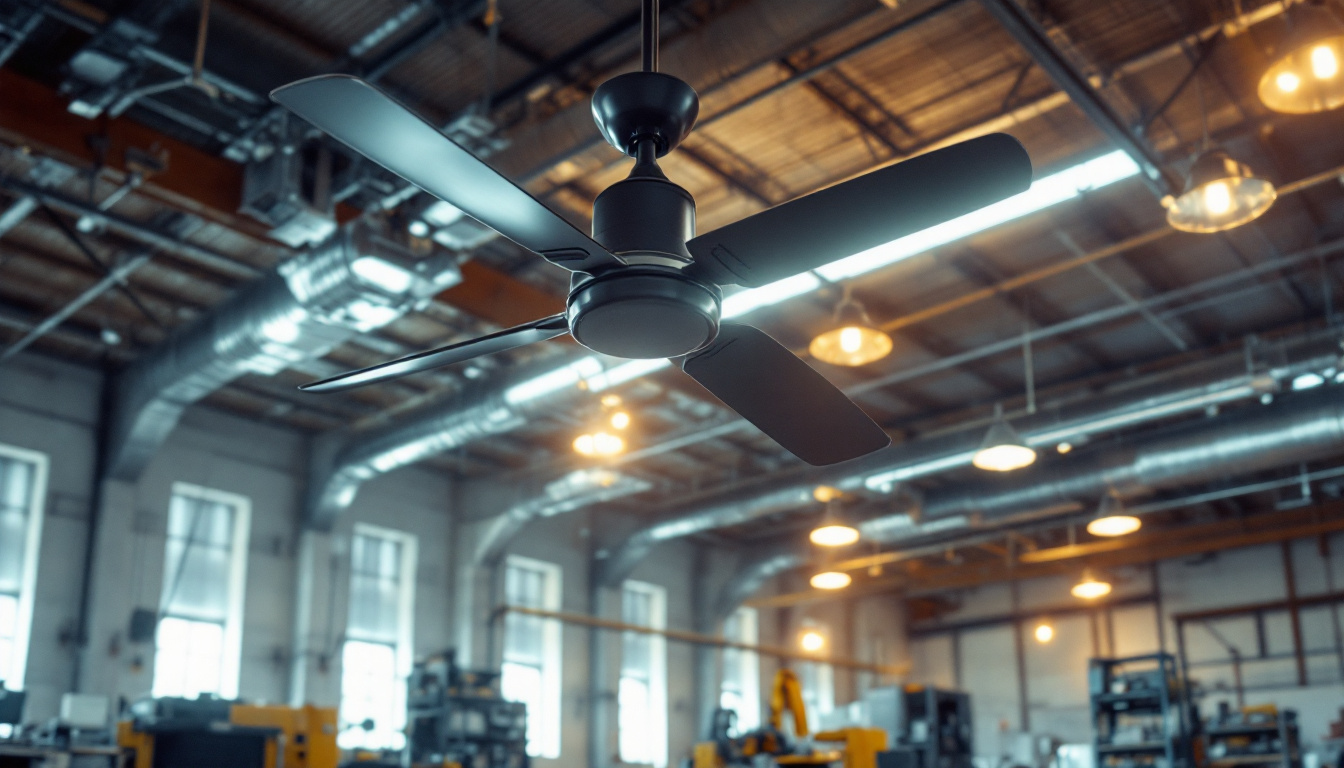

In the world of lighting contracting, maintaining an optimal working environment is crucial for productivity and safety. One often overlooked aspect is the role of exhaust fans in shops. These fans are essential for ensuring proper ventilation, which can significantly affect both the quality of work and the health of the workers.
Exhaust fans help to remove excess heat, humidity, and potentially harmful fumes generated during the installation and repair of lighting fixtures. This is especially important in shops where soldering, painting, or other processes that emit vapors take place. Proper ventilation not only enhances comfort but also minimizes the risk of accidents and health issues.
Implementing exhaust fans in a lighting shop offers numerous benefits. Firstly, they help to regulate temperature, preventing overheating that can lead to equipment malfunction or damage. Additionally, by improving air quality, they create a healthier workspace, reducing the likelihood of respiratory problems among workers.
Moreover, exhaust fans can enhance the longevity of tools and materials. Excessive humidity can lead to corrosion and degradation of electrical components, which can be costly in the long run. By maintaining a balanced environment, exhaust fans contribute to the overall efficiency and effectiveness of the shop. Furthermore, the presence of proper ventilation systems can also foster a more pleasant atmosphere, encouraging creativity and focus among workers as they tackle intricate lighting designs and installations.
When selecting an exhaust fan, it is essential to consider the specific needs of a lighting shop. Different types of exhaust fans serve various purposes. For instance, inline fans are ideal for ducted systems, providing powerful airflow while remaining unobtrusive. On the other hand, wall-mounted fans can be effective for direct ventilation in smaller spaces.
Another option is the roof-mounted exhaust fan, which can efficiently expel hot air and fumes from the top of the building. Each type has its advantages, and the choice will depend on factors such as shop size, layout, and the specific activities conducted within the space. Additionally, it is important to consider the noise levels of the fans, as quieter models can help maintain a more conducive working environment without the distraction of loud machinery. Investing in variable-speed fans can also provide flexibility, allowing for adjustments based on the workload and specific ventilation needs at any given time.
Selecting the appropriate exhaust fan is a critical decision that can impact the overall efficiency of a lighting shop. Several factors come into play when making this choice, including airflow requirements, noise levels, and energy efficiency.
To determine the right exhaust fan, it is essential to calculate the airflow needs of the shop. This is typically measured in cubic feet per minute (CFM). The general rule of thumb is to replace the air in the shop at least 6 to 10 times per hour. This means that the total volume of the shop should be multiplied by the desired air changes per hour to find the necessary CFM rating for the exhaust fan.
For example, if a shop has a volume of 1,000 cubic feet and requires 8 air changes per hour, the calculation would be: 1,000 cubic feet x 8 air changes / 60 minutes = approximately 133 CFM. Understanding these calculations ensures that the chosen exhaust fan can effectively manage the air quality in the workspace. Additionally, it’s important to consider any specific processes that may generate higher levels of heat or fumes, as these may necessitate a fan with a higher CFM rating to maintain a safe and comfortable environment.
Another important aspect to consider when selecting an exhaust fan is the noise level it produces. In a shop environment, excessive noise can be distracting and may hinder communication among workers. Therefore, looking for fans with lower decibel ratings is advisable, especially for shops where employees spend extended periods.
Many modern exhaust fans are designed to operate quietly while still providing efficient airflow. Investing in a quieter model can enhance the working atmosphere, leading to improved focus and productivity. Furthermore, some manufacturers offer fans with sound-dampening features or variable speed settings, allowing for further customization based on the specific needs of the shop. This can be particularly beneficial during quieter tasks or when conducting meetings, ensuring that the environment remains conducive to both work and collaboration.
In addition to airflow and noise levels, energy efficiency is a crucial factor when selecting an exhaust fan. Energy-efficient models can significantly reduce electricity costs over time, making them a smart investment for any shop owner. Look for fans that are ENERGY STAR certified, as these models meet strict energy efficiency guidelines set by the U.S. Environmental Protection Agency.
Moreover, consider the fan’s motor type; brushless DC motors, for instance, tend to be more energy-efficient and have a longer lifespan compared to traditional AC motors. By prioritizing energy-efficient options, shop owners not only contribute to a more sustainable environment but also benefit from reduced operational costs, allowing for reinvestment in other areas of the business.
Once the appropriate exhaust fan has been chosen, proper installation is crucial to ensure optimal performance. The installation process can vary depending on the type of fan and the layout of the shop, but there are some best practices that can be followed.
The placement of the exhaust fan significantly impacts its effectiveness. Ideally, the fan should be located in a position where it can easily expel stale air and draw in fresh air. This often means positioning it near heat sources or areas where fumes are generated, such as soldering stations or painting areas.
Additionally, ensuring that the fan is installed high enough can help to capture rising heat and fumes effectively. Proper ducting is also essential to avoid creating resistance that can diminish the fan’s performance.
To maximize the efficiency of an exhaust fan, it is important to seal any gaps around the installation area. Air leaks can reduce the effectiveness of the fan, allowing unwanted air to enter the shop. Insulating ducts can also prevent heat loss, ensuring that the fan operates efficiently.
Regular maintenance checks should be scheduled to ensure that the fan and ductwork remain in good condition. Cleaning the fan and ducts can prevent blockages and maintain optimal airflow, contributing to a healthier work environment.
In many cases, exhaust fans work best when integrated with other ventilation systems. A comprehensive approach to ventilation can enhance air quality and comfort in a lighting shop.
A balanced ventilation system combines both exhaust and supply fans to ensure that fresh air is continuously brought into the shop while stale air is expelled. This creates a more controlled environment, reducing the risk of pressure imbalances that can lead to drafts or discomfort.
By using a balanced system, lighting contractors can maintain optimal air quality without relying solely on exhaust fans. This can be particularly beneficial in larger shops where air circulation is more challenging.
In addition to exhaust fans, incorporating air purifiers can further improve air quality. Air purifiers can filter out dust, allergens, and other particulates that may be present in the shop environment. This is especially important in lighting shops where fine particles from materials can become airborne.
Combining exhaust fans with air purifiers creates a multi-layered approach to ventilation, ensuring that the air remains clean and safe for workers. This not only enhances comfort but also promotes a healthier workspace.
Regular maintenance of exhaust fans is essential to ensure their longevity and effectiveness. Neglecting maintenance can lead to decreased performance and even premature failure of the fan.
Conducting routine inspections of the exhaust fan and its components is vital. This includes checking for any signs of wear or damage, such as frayed wires or loose connections. Additionally, inspecting the fan blades for dust buildup can help maintain optimal airflow.
Scheduling these inspections at regular intervals can catch potential issues before they become significant problems, saving time and money in the long run.
Cleaning the exhaust fan and ductwork is another crucial aspect of maintenance. Dust and debris can accumulate over time, obstructing airflow and reducing the fan’s efficiency. Regular cleaning ensures that the fan operates at peak performance.
Servicing the fan may also involve lubricating moving parts and checking electrical connections. Following the manufacturer’s recommendations for maintenance can help prolong the life of the fan and ensure it continues to function effectively.
In conclusion, the integration of exhaust fans in a lighting shop is not just an option; it is a necessity for creating a safe and efficient working environment. By understanding the importance of ventilation, choosing the right exhaust fan, and implementing best practices for installation and maintenance, lighting contractors can significantly enhance their workspace.
Moreover, the combination of exhaust fans with other ventilation systems, such as air purifiers, can lead to a more comprehensive approach to air quality management. This not only benefits the health and comfort of workers but also contributes to the overall success of the lighting contracting business.
Ultimately, investing in proper ventilation solutions is a proactive step toward ensuring a productive and safe environment in lighting shops. By prioritizing air quality, contractors can focus on their work, knowing that they are providing the best possible conditions for themselves and their teams.
Ready to elevate your lighting shop’s efficiency and safety with the right ventilation solutions? Look no further than LumenWholesale, where we provide contractors with top-quality, spec-grade lighting products at unbeatable wholesale prices. Our selection is designed to meet the highest industry standards, ensuring you get reliable, high-performance lighting for every project. Plus, with free shipping on bulk purchases, you can secure premium lighting at the best value — without hidden fees or compromises. Enhance your workspace today and experience the perfect blend of quality, affordability, and convenience. Visit LumenWholesale for Wholesale Lighting at the Best Value.

Illuminate your outdoor space efficiently with our comprehensive guide on driveway lights solar.

Discover the essential insights every lighting contractor needs to master recessed lighting.

Discover essential insights for lighting contractors on industrial ceiling fans, including installation tips, energy efficiency benefits, and design considerations to enhance commercial spaces..

Discover why purchasing LED magnetic strip retrofit kits in bulk from local distributors might not be your best choice.
Get notified when NEW deals are released.
Optimize your budget with wholesale discounts.
Only top-quality, specification-grade lighting products.
No additional costs at checkout - what you see is what you pay.
We understand the unique needs of contractors.